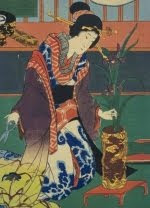From the start of land art it has been an art form related to conceptual art, and in some cases also to installation and performance. Some argues that land art is the correct term for conceptual art that is created outdoors, while installation art is it's indoor equivalent. Labeling things can be interesting, but the crossing of borders and combining of different expressions often makes it difficult and not so fruitful.
The Japanese ikebana artist Yukio Nakagawa has been an influential exponent for an experimental approach to art. Nakagawa was born in 1918 and died earlier this year. Starting out as a traditional ikebana artist of the Ikenobo school, in 1950 Nakagawa joined the non-conformist ikebana research group Byakutosha organized by landscape architect Mirei Shigemori. Since 1956 he's been working independently, developing his avant-garde and revolutionary approach to flowers.
For this blogpost I've chosen two of Yukio Nakagawa's later works that are related to ikebana, land art, installation and performance: His 2002 outdoor performance Hana Gurui [Flower Crazy], a collaboration with Butoh legend Kazuo Ohno. And Ondes oniriques, a 2003 installation at Maison Hermès in Tokyo. In both these works Nakagawa uses an overwhelming amount of flower petals - apart from that they are quite different works.
The performance Hana Gurui took place on the Shinano riverbed in Niigata prefecture and was documented in the 2002 movie An Offering To Heaven. 95 year old dancer Kazuo Ohno sits in a chair in the open air while a helicopter flies overhead and drops half a million flower petals down over him. The wheelchair bound man is dancing in his chair under the swirling shower of petals in the rain.
The performance Hana Gurui took place on the Shinano riverbed in Niigata prefecture and was documented in the 2002 movie An Offering To Heaven. 95 year old dancer Kazuo Ohno sits in a chair in the open air while a helicopter flies overhead and drops half a million flower petals down over him. The wheelchair bound man is dancing in his chair under the swirling shower of petals in the rain.
Is Hana Gurui land art? Not if the term is limited to site specific works made from natural materials found on the location. Neither is it proper ikebana - the arranging of the flowers in this work is far too random. How would you label this work? Maybe it's an outdoor flower performance informed by land art and ikebana?
In the other work, Ondes oniriques (2003) [Dreamlike Waves], Yukio Nakagawa arranged 700 kilos of stemless lavender blossoms, some of which he died in cobalt blue, in swirls and waves reminiscent of a zen garden. Nakagawa says he wanted to represent its depth rather than its superficial beauty,
and offer the gentle invitation of its fragrance. Visitors at the Maison Hermès exhibition were allowed to interact with the installation by throwing the flowers as they wished.
I wouldn't call Ondes oniriques a site specific work. Nakagawa explains that it's more a reconstruction of his feelings when he experienced a lavender field in France. One could argue that this is an example of land art in an exhibition gallery, representing a nature phenomenon. But how is this ikebana? Ikebana is a meditative and intuitive art form, but it is also about philosophy and skills passed down through tradition. In my opinion too little has been done to analyze contemporary ikebana works from an ikebana perspective. Or maybe I just haven't looked in the right places. What is your opinion?
Read the exhibition words by the artist at Maison Hermès
See more photos of Ondes oniriques on designboom.
Read more about the artist on the official website of Yukio Nakagawa.
I wouldn't call Ondes oniriques a site specific work. Nakagawa explains that it's more a reconstruction of his feelings when he experienced a lavender field in France. One could argue that this is an example of land art in an exhibition gallery, representing a nature phenomenon. But how is this ikebana? Ikebana is a meditative and intuitive art form, but it is also about philosophy and skills passed down through tradition. In my opinion too little has been done to analyze contemporary ikebana works from an ikebana perspective. Or maybe I just haven't looked in the right places. What is your opinion?
 |
Photo courtesy Hermès Japon Co, via designboom.com
|
"I would like to express the lives of flowers" (Yukio Nakagawa)
Read the exhibition words by the artist at Maison Hermès
See more photos of Ondes oniriques on designboom.
Read more about the artist on the official website of Yukio Nakagawa.


















No comments:
Post a Comment